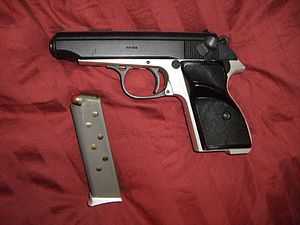FEG PA-63
| FÉG PA-63 | |
|---|---|
 FÉG PA-63 | |
| Type | Semi-automatic pistol |
| Place of origin |
|
| Service history | |
| Used by | Hungary |
| Production history | |
| Designer | FÉG |
| Designed | Late 1950s |
| Manufacturer | FÉG |
| Specifications | |
| Weight | 595 g (21.0 oz) |
| Length | 175 mm (6.9 in) |
| Barrel length | 100 mm (3.9 in) |
|
| |
| Cartridge | 9x18mm Makarov |
| Action | blowback |
| Muzzle velocity | 315 m/s (1,033 ft/s) |
| Effective firing range | 50 m (164 ft) |
| Feed system | 7-round detachable box magazine |
| Sights | blade front, notch rear |
The FÉG PA-63 is a semi-automatic pistol designed and manufactured by the FÉGARMY Arms Factory of Hungary.
History
FÉGARMY Arms Factory of Hungary started producing Walther PP/PPK clones in the late 1940s starting with their Model 48 which differed from the Walther PP only in minor details. By the late 1950s FÉG began making broader changes resulting in the PA-63, which uses a 9x18mm Makarov round. It quickly became standard issue to both Hungarian military and police forces. Due to its popularity and relative durability FÉG later issued models using .32ACP and .380 ACP caliber rounds (FÉG AP7.65 and PMK-380 respectively).[1]
The Military standard PA-63 version sports a two-tone polished aluminum frame with black slide, grips, trigger and hammer assembly.[1] While unusual for military issue in that a reflective polish was used, it was chosen due to its relative cheapness as well as quicker build time.[2]
The Makarov Label
PA-63s sold in the United States are often advertised as "PA-63 Makarov." This can lead some consumers to believe they are purchasing a Makarov PM pistol instead of a different pistol chambered for the same 9x18mm Makarov caliber. Though both pistols share lineage from the Walther PP/PPK, similar operating principles and use the same ammunition, the Makarov PM is a different design featuring all-steel construction and different lockwork. There are no parts in common between the FÉG PA-63 and the Makarov PM.[1]
Compromises of the PA-63
The PA-63 design reflects a compromise between police and military needs.
The safety/decocking lever, located on the rear of the slide, must be pushed forward to disengage the safety. Aficionados of the John Browning-designed Model 1911 or the Makarov PM may find this design unfamiliar, although those with experience using more modern designs such as the Walther PPK or Beretta M9 pistols will find the safety/decocking lever to be located in a similar position.
The 7-round magazine capacity is much lower than many newer service pistol designs.
Due to its lighter-weight alloy construction, the PA-63 handgun produces more noticeable recoil than the similarly sized, all steel Makarov PM, and some shooters may note an increased tendency toward muzzle flip with each shot. This tendency can be reduced by replacing the stock recoil spring with a stronger one, readily available as an aftermarket item.
Many of the objections raised to the PA-63 have to do with its perception as a military service pistol in the tradition of the American M1911A1, the Russian Tokarev, the German Walther P-38 and P-08 Luger, or the Browning High-Power. As its design can be traced back to a German pocket pistol intended for concealed carry in a pocket or under a coat rather than in a holster on the battlefield, these objections are perhaps understandable. After the fall of communism in 1990, the Hungarian army and police units initiated a program to replace the PA-63 with pistols using the NATO standard 9x19mm Parabellum cartridge, first the imported Jericho 941, followed by the domestically produced P9RC, but the PA-63 is still in service in Hungarian law enforcement.
FÉG AP9, PMK-380 & FÉG PPH
A lesser known variant of the PA-63 is the AP9. This pistol is almost identical to the PA-63 except for the fact that it is chambered in 7.65 mm (.32 auto) and is anodized not two toned. Another variant is the PMK-380 which closely resembles the AP9 but is chambered in the .380 ACP cartridge.[3]
References
- ↑ 1.0 1.1 1.2 Cutshaw, Charles Q. (28 February 2011). Tactical Small Arms of the 21st Century: A Complete Guide to Small Arms From Around the World. Iola, Wisconsin: Gun Digest Books. p. 86. ISBN 978-1-4402-2709-7. Retrieved 10 July 2013.
- ↑ John Ivor Headon Owen (1976). Warsaw Pact Infantry and Its Weapons: Manportable Weapons and Equipment in Service with the Regular and Reserve Forces of the Soviet Union, Bulgaria, Czechoslovakia, German Democratic Republic, Hungary, Poland and Rumania, and of Yugoslavia. Brassey's Publishers Limited. p. 34. ISBN 978-0-904609-03-5.
- ↑ "Makarov.com - Other Pistols". Retrieved 9 May 2012.
Ian V. Hogg and, John Walter (2004). Pistols of the World, 4th Ed. Iola, Wisconsin: Krause Publications. ISBN 0-87349-460-1.
Hartink, A.E. (2003). The Complete Encyclopedia of Pistols and Revolvers. Edison, New Jersey: Chartwell. ISBN 0-7858-1871-5.